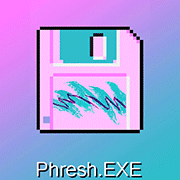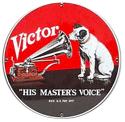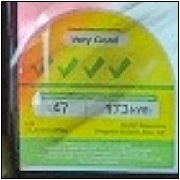|
LimaBiker posted:I've had that issue with someone who painstakingly digitized a lot of pretty rare records, then ran an equalizer on them to make them sound better (which they did, he does have an ear for that kind of stuff). All with really high quality speakers, though speakers that didn't realistically reproduced very low frequencies in his room partially due to standing waves. Any LP transfer should be equalizing out anything under ~20Hz. There's a reason those '70s receivers had an "infrasonic" filter. I don't care how nice of a turntable you have, rumble around 10-15Hz is basically unavoidable in playback. Blindly pushing the "more bass" button is going to give you huge amounts of it, and easily contribute to the early death of your system. Anyone who is doing ~*SCIENTIFIC EQUALIZATION*~ strtj fucked around with this message at 21:24 on Aug 2, 2022 |
|
|
|

|
| # ? May 15, 2024 20:17 |
|
strtj posted:Any LP transfer should be equalizing out anything under ~20Hz. There's a reason those '70s receivers had an "infrasonic" filter. I don't care how nice of a turntable you have, rumble around 10-15Hz is basically unavoidable in playback. Blindly pushing the "more bass" button is going to give you huge amounts of it, and easily contribute to the early death of your system. Anyone who is doing ~*SCIENTIFIC EQUALIZATION*~ I mean, with the RIAA standard they were running on, anything lower than 20hz or higher than 20k hz is literally not even engraved on the LP, no?
|
|
|
|
strtj posted:Please give us $2k for an amplifier that has been specially modded to have as much harmonic distortion as possible and probably blow up if you run it for too long at high power: Sorry, I can’t hate this. It’s an updated version of one of the most historically influential amps, uses parts with higher tolerances, has perfectly fine stats in ultra linear mode, and fixes the major flaw of the original, which was the tube rectifier. Is it expensive? Yes. It’s a low-production kit, and the output transformers are heavy and expensive. But the people I’ve seen building and buying these are typically pretty far removed from the audiophile BS crowd. They tend to be more of the ‘nostalgia for its own sake’ type.
|
|
|
|
TheMadMilkman posted:Sorry, I can’t hate this. It’s an updated version of one of the most historically influential amps, uses parts with higher tolerances, has perfectly fine stats in ultra linear mode, and fixes the major flaw of the original, which was the tube rectifier. Agreeing with this. I had a Will Vincent something-something rebuilt ST70 that I found very charming and nice to use, and it helped me understand that output transformers dealt nicely with electrostats and thus drove me towards a McIntosh amp once I got tired of the heat of tubes. Certainly didn't sound as clear and accurate as a cheap-but-measures-well class D amp, but the "haze" or whatever you call it was genuinely enjoyable (and frankly, not all *that* noticeable if you weren't looking for it) and it didn't do the thing my class D amps did where sometimes the e-stats would get to a difficult part of their impedance curve make the amps do ~~weird poo poo~~.
|
|
|
|
RIP Paul Walker posted:Agreeing with this. I had a Will Vincent something-something rebuilt ST70 that I found very charming and nice to use, and it helped me understand that output transformers dealt nicely with electrostats and thus drove me towards a McIntosh amp once I got tired of the heat of tubes. Certainly didn't sound as clear and accurate as a cheap-but-measures-well class D amp, but the "haze" or whatever you call it was genuinely enjoyable (and frankly, not all *that* noticeable if you weren't looking for it) and it didn't do the thing my class D amps did where sometimes the e-stats would get to a difficult part of their impedance curve make the amps do ~~weird poo poo~~. "I'm hooking a very high distortion amp to the lowest distortion speakers I can find." Also what class D stuff were you running? The cheap stuff is nothing but cheap.
|
|
|
|
Mederlock posted:I mean, with the RIAA standard they were running on, anything lower than 20hz or higher than 20k hz is literally not even engraved on the LP, no? It's mostly equalized away in the cutting process but if it's there in appreciable amounts it'll come through. Also that assumes that your cutting engineer is still following the RIAA curve guidelines - nothing says they have to, and you could always cut super wacko stuff like the record that was a live recording of an actual earthquake (Cook Labs, maybe?) and was basically unplayable. The general rule is that anything under 20Hz will cause tracking issues, especially if it's cut in stereo, so no one does that. Anything above 20 kHz probably isn't going to transfer too well unless everything is really perfectly aligned, and it's not like anyone can hear it anyway. But if you look at an LP transfer done on good quality equipment you'll still see frequencies outside of that range. Anything under 15 Hz is absolutely rumble from the turntable, full stop, and you'd be surprised how much of it there is. Anything above 20 kHz is generally just harmonic distortion, but people get really into "I NEED TO TRANSFER THIS AT 96 kHz SO IT PRESERVES EVERY DETAIL OF THE ORIGINAL RECORDING," full well ignoring that the frequencies in the range that captures are both inaudible and the result of weaknesses inherent in the medium.
|
|
|
|
strtj posted:"I'm hooking a very high distortion amp to the lowest distortion speakers I can find." Also what class D stuff were you running? The cheap stuff is nothing but cheap. Lol, I mean, yeah I guess. It looked cool as gently caress and still made lovely music and was a unique experience and I enjoyed myself even knowing it was a not-perfect thing. Sorry if my post offended your sensibilities. Icepower 125ASX2 and Aiyima A07. The Icepower would be weird sometimes, the A07 was basically flawless but maybe a little harsh sometimes. My mc2100 combines the smoothness and effortlessness of the tube amp with the clarity of the other solid state stuff and also looks super cool. Amp shopping consisted of showing my girlfriend pictures of 100ish watt McIntosh autoformer amps and asking which she thinks would look best sitting under the TV. I’m probably a bad audiophile who should be ridiculed.
|
|
|
|
RIP Paul Walker posted:I’m probably a bad audiophile who should be ridiculed. On that note, this evening I had to work late. So why not ratchet strap an electromagnetic motor that exerts 20 kN of force to my office chair, hook it up to a 160V peak channel of Class D amplifier and run tunes through a sub harmonic synth to really get that 10-55 Hz going right through my spine?  I’ve got another 3 of these things (Powersoft Mover Inertial Drive) and plenty of amp channels to stick up them. I’m now very curious whether it’s possible to disassemble a Herman Miller Aeron through indirect vibrational force.
|
|
|
|
Well I for one am thankful you brought the content to us, so we'll spare you a few millidisparagements
|
|
|
|
If you’re producing bass heavy music for vinyl, make sure your sub bass and bass frequencies are all in mono.
|
|
|
|
Dirt Road Junglist posted:If you’re producing bass heavy music for vinyl, make sure your sub bass and bass frequencies are all in mono. I imagine the idea is so the needle jumps straight up and down instead of being yeeted off the groove at a 45? degree angle, if the bass was all on one side of the mix?
|
|
|
|
It's generally a good idea to mono-sum everything <120Hz or so even if you aren't mixing for vinyl, since we don't really perceive those frequencies as directional anyway, and phasing issues can make things sound gross in anything but an ideal listening environment. You can do some cool psychoacoustic stuff for picture with decorrellated bass frequencies, but music is a different story. The playback system in the nightclub you're at is probably already in mono, the bass if not the entire thing. But yeah, for vinyl it will literally make the needle act wonky because of the way stereo information is encoded in the axes of the groove. Tangentially related, another thing about the extreme low-frequency attenuation in the RIAA curve is that if the bass is too loud, the grooves are so wide that the song doesn't fit on the record.
|
|
|
|
RIP Paul Walker posted:Lol, I mean, yeah I guess. It looked cool as gently caress and still made lovely music and was a unique experience and I enjoyed myself even knowing it was a not-perfect thing. Sorry if my post offended your sensibilities. I mean, you are voluntarily seriousposting in a mock thread. You do seem to have a preference for harmonic distortion and you know what? That's okay, as long as you realize that's what's happening and you're not pretending that you're getting a high quality reproduction of your input. And buying stuff because it looks cool first and performs reasonably second is okay too, but if you come into this thread and do it you have to expect at least a little bit of ribbing.
|
|
|
|
Mister Speaker posted:It's generally a good idea to mono-sum everything <120Hz or so even if you aren't mixing for vinyl, since we don't really perceive those frequencies as directional anyway, and phasing issues can make things sound gross in anything but an ideal listening environment. You can do some cool psychoacoustic stuff for picture with decorrellated bass frequencies, but music is a different story. The playback system in the nightclub you're at is probably already in mono, the bass if not the entire thing. I would argue that we've come to expect low bass to be in mono because of things like 5.1 and 7.1 surround which are mixed for a single subwoofer, or dance/pop which just want to hit those freqs as hard as possible. If I were mixing for a movie or a boy band of course I would mono-sum everything below the crossover frequency of whatever was the most popular subwoofer at Best Buy. But there's no substitute for the sense of stereo you can get with two full-range speakers, and that includes very low bass frequencies. quote:But yeah, for vinyl it will literally make the needle act wonky because of the way stereo information is encoded in the axes of the groove. Tangentially related, another thing about the extreme low-frequency attenuation in the RIAA curve is that if the bass is too loud, the grooves are so wide that the song doesn't fit on the record. That's why the 12" single was so popular for dance music. You could cut really wide grooves and not have to worry about playing time.
|
|
|
|
strtj posted:But there's no substitute for the sense of stereo you can get with two full-range speakers, and that includes very low bass frequencies. It really doesn't. We've come to expect low bass to be omnidirectional, not 'in mono', because that's the way our hearing and the acoustics of space simply works. Nothing is necessarily 'mixed for one subwoofer', the LFE is there to fill out the low octave and while placement certainly matters, there is absolutely no directionality benefit to having two subs beneath each of your stacks vs. one placed properly in the room. The idea that there's a 'sense of stereo' below ~80Hz is audiophile poo poo; all of the directionality you think you perceive from anything lower than that (probably much higher actually) is just higher harmonic information being interpreted by your brain. Sure, go nuts and buy the 7.2 system or the giant 'near-field-no-more' monitors that preclude the need for a sub, but recognize that the only reason such setups exist is because more drivers doing less work generally means less distortion. You'll probably also get better coverage at different listening positions. It has nothing to do with stereo image at those frequencies. Especially not when there isn't any to begin with because mix engineers have been sending <150Hz down the middle for decades. Mister Speaker fucked around with this message at 11:22 on Aug 4, 2022 |
|
|
|
Mister Speaker posted:It really doesn't. http://www.davidgriesinger.com/multichan.pdf
|
|
|
|
Like I said, audiophile poo poo. If you think your system is good enough that any of that is appreciable, enjoy your soundstage. I'll be out at a show where all two dozen bass bins are working toward the greater good.
|
|
|
|
Have you been in a Dolby Cinema? The sizzle reel at the beginning has a side to side very low bass pan and it was genuinely surprising the first time I heard it. My understanding is you can do stereo with low bass it just takes a lot of power and perfect processing and positioning [like one would find in, say, a multimillion dollar professional theater install] and It's not really practical for anything less than that.
|
|
|
|
strtj posted:I mean, you are voluntarily seriousposting in a mock thread. Ah that’s a good point, the serious thread is too drat serious tho. I am happy to get some ribbing, I did just want to clarify a bit the difference between enjoying harmonic distortion as a unique historical experience and having it be my preference :-) I was looking to the McIntosh amps because their distortion levels are pretty dang low and I’m fairly convinced transformers make electrostats an easier load on amplifiers. Tho to be fair to your point, I did debate between the AHB2 and a McIntosh and went with a Mc 40% because of autoformers and 60% because of looks. We need a serious-but-not-so-serious audio thread! I wanna post about my low distortion flat-FR-in-room Dirac’d Quad ESLs and five bass managed subwoofers as well as what trying vintage/different gear is like. Back on topic: if you get a set of expensive cables for “free” with a used speaker purchase, are you an idiot for not selling them? I ended up with a pair of $650 MSRP AudioQuest speaker cables going to a Magnepan DWM woofer and feel like I should try and extract money from them instead. They are one of the few cables that I’ve noticed sound different (worse), so I’d feel kinda bad selling them but also not really. The back of the woofer isn’t super visible otherwise I’d definitely keep them just to look like I have money to burn.
|
|
|
|
RIP Paul Walker posted:
Nah, post there and if they kvetch just say "yo vintage poo poo is my hobby, I don't give a gently caress" Alternatively, lean into it and see if you can't raise their blood pressure RE: the cables, if you can sell them to a bullshit artist or store sure-otherwise you're just in on the grift
|
|
|
|
I would argue it's more ethical to sell them on somewhere like Audiogon because a) it's a self-selected audience of people looking for that exact thing and b) you're preventing a sale to Audioquest and a shady dealer who are the real villains here.
|
|
|
|
qirex posted:Have you been in a Dolby Cinema? The sizzle reel at the beginning has a side to side very low bass pan and it was genuinely surprising the first time I heard it. My understanding is you can do stereo with low bass it just takes a lot of power and perfect processing and positioning [like one would find in, say, a multimillion dollar professional theater install] and It's not really practical for anything less than that. This isn't rocket science, you can make a 30 Hz sine wave that plays only in the left channel for a few seconds and only in the right channel for a few seconds, and I guarantee you will be able to tell which channel is playing if you have a reasonable system.
|
|
|
|
Looks like we're in the part of the argument where it's time to cite sources! Or! Upload some example files for us to all listen to!
|
|
|
|
LRADIKAL posted:Looks like we're in the part of the argument where it's time to cite sources! Or! Upload some example files for us to all listen to! I feel like I already cited a source, but I can probably find more if that would make people feel better. In the meantime, please enjoy this FLAC file that is a 30 Hz sound in one channel for 10 seconds, one second of silence, and then a 30 Hz sound in the other channel for 10 seconds. https://www.mediafire.com/file/ep37ugqsfhd6hs6/30hz.flac/file
|
|
|
|
Here's what I have with a quick search, I'll see if I can find copies of the referenced papers. https://web.archive.org/web/20200812034930/https://www.audioholics.com/room-acoustics/stereo-bass. This deals heavily with the conclusions of the author of the paper I posted earlier. The basic conclusion here is that... the author of the blog hedges his bets. My position is this: maybe if you were in a perfectly isolated environment with no walls, you would not be able to tell where the bass was coming from. But in the real world, any venue or listening room of any size is going to have reflections, so there will be some sort of perception of directionality based on those reflections. Now, can you accurately record and reproduce those reflections for an arbitrary listener? I honestly don't know, and that's what there is an ongoing debate about. strtj fucked around with this message at 23:17 on Aug 4, 2022 |
|
|
|
lmao i couldn't find speaker cables locally that aren't hideously overpriced without directly buying from china ($8 for 3 meters with gold banana plugs) nice job audiophiles
|
|
|
|
Audiowned
|
|
|
|
Yeah, all right, a 30Hz tone played out of each channel discretely is going to sound like it's coming from one speaker or another. Big huge revelation. I'm gonna concede that initial point that "we've come to expect low bass to be in mono" being the reason that everything is mixed that way, but really, would you have it any other way? If the eXpErImEnTaTiOn of the Beach Boys and Beatles was anything more, would music be more interesting for it? I don't loving think so. You'd go to a Yes concert and vomit because Squire was experimenting with his bass through a Leslie cabinet and mic'd up proper good. Like I said the first time, there are some wiiild effects you can get as a sound designer for picture, if you're meticulous with the low end decorrellation. Sound for picture should be disorienting when it needs to be. But music is different, and it always has been. Some bands hard-panned lots of things in the 60s but you honestly don't want to listen to a loving hour of that, do you? Most people figured out, probably before amplification even, that it's better when certain mix elements are right in the middle, and stereo information generally does jack poo poo for those mix elements. In this way, there really isn't any difference between some guy who plays you a Zeppelin LP on his tuned hi-fi with a subwoofer, and the same guy from an alternate dimension where he's just got bigger bass drivers and no sub. Again, this is audiophile poo poo.
|
|
|
|
Mister Speaker posted:You'd go to a Yes concert and have the privilege of vomiting because Squire was experimenting with his bass through a Leslie cabinet and mic'd up proper good. ftfy
|
|
|
|
Whoa I wanna make people barf with sound, I thought you could only do that with Nickelback
|
|
|
|
Mister Speaker posted:Yeah, all right, a 30Hz tone played out of each channel discretely is going to sound like it's coming from one speaker or another. Big huge revelation. I'm gonna concede that initial point that "we've come to expect low bass to be in mono" being the reason that everything is mixed that way, but really, would you have it any other way? If the eXpErImEnTaTiOn of the Beach Boys and Beatles was anything more, would music be more interesting for it? I don't loving think so. You'd go to a Yes concert and vomit because Squire was experimenting with his bass through a Leslie cabinet and mic'd up proper good. Like I said the first time, there are some wiiild effects you can get as a sound designer for picture, if you're meticulous with the low end decorrellation. Sound for picture should be disorienting when it needs to be. But music is different, and it always has been. Some bands hard-panned lots of things in the 60s but you honestly don't want to listen to a loving hour of that, do you? Most people figured out, probably before amplification even, that it's better when certain mix elements are right in the middle, and stereo information generally does jack poo poo for those mix elements. In this way, there really isn't any difference between some guy who plays you a Zeppelin LP on his tuned hi-fi with a subwoofer, and the same guy from an alternate dimension where he's just got bigger bass drivers and no sub. Good username/post combo
|
|
|
|
Mr. Mercury posted:Whoa I wanna make people barf with sound, I thought you could only do that with Nickelback South Park did a whole episode about the fabled brown note
|
|
|
|
Yeah but that isn't real, I wanna make other people barf on command not just myself
|
|
|
|
Assuming the yellow-green note is a specific frequency, it should be possible to set up a room where the frequency has a dead spot due to reflection and/or stereo shenanigans. So you just need to be exactly there. Sort of the opposite of the suspicions chair location.
|
|
|
|
Eh, seems like it's only possible in people with a somewhat rare bone variation near the cochlea I've exhausted all available brainpower for this joke
|
|
|
|
WaPo posted:Mike Esposito still won’t say who gave him the tip about the records. But on July 14, he went public with an explosive claim. lol
|
|
|
|
lmao I have a few mofi releases, but they're all CD or SACD. We collect CDs like some people collect vinyl. I don't care about warmth or whatever, but I do like physical media, and records are too big.
|
|
|
|
I kind of feel for Mofi, imagine being able to get $100 for a copy of the album with the most physical copies of any in history, the temptation must be too strong. That said companies misrepresenting their product is garbage but if you sell garbage to garbage consumers is it really wrong?
qirex fucked around with this message at 23:56 on Aug 5, 2022 |
|
|
|
Yesterday: these mofi records are the best thing I've ever heard, perfecting mastering just how I like it and I know because I have a perfect ear Today: these records are trash bullshit that sound bad
|
|
|
|

|
| # ? May 15, 2024 20:17 |
|
The term cognitive dissonance has been popularized to the point that it's often not used correctly. I'm wagering a massive percentage of MoFi's customer base is putting on a clinic in its correct meaning dealing with this story. Goddamn I'm laughing so hard.
|
|
|

































